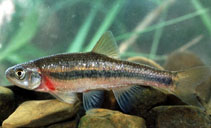http://www.fishbase.org/Summary/speciesSummary.php?genusname=Clinostomus&speciesname=funduloides ---> http://52.67.158.155/Summary/speciesSummary.php?genusname=Clinostomus&speciesname=funduloides
http://52.67.158.155/Summary/speciesSummary.php?genusname=Clinostomus&speciesname=funduloides ---> https://fishbase.net.br/Summary/speciesSummary.php?genusname=Clinostomus&speciesname=funduloides
https://fishbase.net.br/Summary/speciesSummary.php?genusname=Clinostomus&speciesname=funduloides ---> https://fishbase.net.br/summary/Clinostomus-funduloides.html
Clinostomus funduloides, Rosyside dace

You can
sponsor
this page
Common name (e.g. trout)
Genus + Species (e.g. Gadus morhua)
-

-
About this page
-
Languages
-
User feedbacks
-
Citation
-
Uploads
-
Related species
-


 Rosyside dace
Upload your
photos
and
videos
Rosyside dace
Upload your
photos
and
videos
Pictures
|
Google image
 Clinostomus funduloides
Clinostomus funduloides
Picture by
Crippen, C.
Teleostei (teleosts) >
Cypriniformes
(Carps) >
Leuciscidae
(Minnows) > Pogonichthyinae
Etymology:
Clinostomus:
Greek, klinein, kline = sloping and bed, due to the four apophyses of sphenoid bone + Greek, stoma = mouth (Ref.
45335
)
;
funduloides:
From the words
clino
-- inclined,
stomus
-- mouth and
funduloides
, meaning
Fundulus
-like (Ref.
10294
)
.
More on author:
Girard
.
Environment: milieu / climate zone / depth range / distribution range
Ecology
Freshwater; demersal. Temperate; 41°N - 33°N
North America: Atlantic Slope (mostly above Fall Line) from lower Delaware River drainage in Pennsylvania to Savannah River drainage in Georgia, USA; Ohio River basin in West Virginia and Ohio to northeast Mississippi, USA. Three subspecies were recognized:
Clinostomus funduloides funduloides
;
Clinostomus funduloides estor
; and undescribed subspecies.
Size / Weight / Age
Maturity: L
m
?
range ? - ? cm
Max length : 11.5 cm TL male/unsexed; (Ref.
10294
); common length : 6.7 cm TL male/unsexed; (Ref.
12193
)
Anal
soft rays
: 9.
Clinostomus funduloides
can be distinguished by the following characters: complete decurved lateral line with 43-57 lateral scales; anal fin with 9 rays; pharyngeal teeth 2,5-4,2; mouth large and oblique; snout long and pointed; caudal fin large and forked; small scales; dorsal fin origin behind pelvic fin origin. Compressed boy, olive above, dark stripe along back, dark-edged scales on upper side; green to yellow-gold stripe (brightest on large individuals) above dusky stripe along silver side; scattered dark blotches on side of large individuals; white, orange or red lower side; breeding male has dark blue above, bright brick red lower side. Similar to
Clinostomus elongatus
,
Luxilus chrysocephalus
and
L. cornutus
(Ref.
86798
).
Inhabits rocky flowing pools of headwaters, creeks and small rivers. Usually occurs in small clear streams (Ref.
86798
).
Life cycle and mating behavior
Maturity
|
Reproduction
|
Spawning
|
Eggs
|
Fecundity
|
Larvae
Page, L.M. and B.M. Burr
, 2011. A field guide to freshwater fishes of North America north of Mexico. Boston : Houghton Mifflin Harcourt, 663p. (Ref.
86798
)
IUCN Red List Status (Ref.
130435
)
Least Concern (LC)
; Date assessed:
04 November 2011
CITES
Not Evaluated
Not Evaluated
Threat to humans
Harmless
Human uses
FAO - Publication:
search
|
FishSource
|
More information
Countries
FAO areas
Ecosystems
Occurrences
Introductions
Stocks
Ecology
Diet
Food items
Food consumption
Ration
Common names
Synonyms
Metabolism
Predators
Ecotoxicology
Reproduction
Maturity
Spawning
Spawning aggregation
Fecundity
Eggs
Egg development
Age/Size
Growth
Length-weight
Length-length
Length-frequencies
Morphometrics
Morphology
Larvae
Larval dynamics
Recruitment
Abundance
BRUVS
References
Aquaculture
Aquaculture profile
Strains
Genetics
Electrophoreses
Heritability
Diseases
Processing
Nutrients
Mass conversion
Collaborators
Pictures
Stamps, Coins Misc.
Sounds
Ciguatera
Speed
Swim. type
Gill area
Otoliths
Brains
Vision
Tools
Bio-Quiz
|
E-book
|
Field guide
|
Length-frequency wizard
|
Life-history tool
|
Point map
|
Classification Tree
|
Catch-MSY
|
Special reports
Check for Aquarium maintenance
|
Check for Species Fact Sheets
|
Check for Aquaculture Fact Sheets
Download XML
Summary page
|
Point data
|
Common names
|
Photos
Internet sources
AFORO (otoliths) |
Alien/Invasive Species database
|
Aquatic Commons
|
BHL
|
Cloffa
|
BOLDSystems
|
Websites from users
|
Check FishWatcher
|
CISTI
|
Catalog of Fishes
:
genus
,
species
|
DiscoverLife
|
ECOTOX
| FAO - Publication:
search
|
Faunafri
| Fishipedia |
Fishtrace
| GenBank:
genome
,
nucleotide
|
GloBI
|
Google Books
|
Google Scholar
|
Google
| IGFA World Record |
MitoFish
|
Otolith Atlas of Taiwan Fishes
|
PubMed
| Reef Life Survey | Socotra Atlas |
Tree of Life
| Wikipedia:
Go
,
Search
| World Records Freshwater Fishing |
Zoobank
|
Zoological Record
Estimates based on models
Phylogenetic diversity index (Ref.
82804
): PD
50
= 0.7500 [Uniqueness, from 0.5 = low to 2.0 = high].
Bayesian length-weight: a=0.00501 (0.00232 - 0.01084), b=3.13 (2.94 - 3.32), in cm total length, based on LWR estimates for this (Sub)family-body shape (Ref.
93245
).
Trophic level (Ref.
69278
): 2.7 ±0.34 se; based on food items.
Resilience (Ref.
120179
): High, minimum population doubling time less than 15 months (Preliminary K or Fecundity.).
Fishing Vulnerability (Ref.
59153
): Low vulnerability (10 of 100).
Back to Search
Random Species
Back to Top
Accessed through:
Not available
FishBase mirror site :
Laguna, Philippines
Page last modified by :
mrius-barile
|